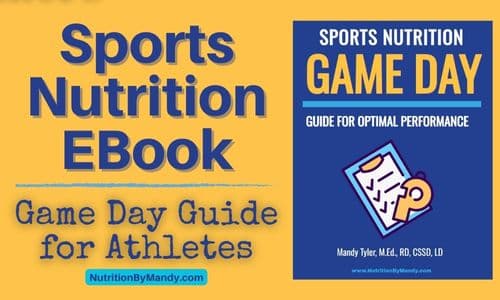Last Updated on December 23, 2024 by Mandy Tyler, M.Ed., RD, CSSD, LD
Best High-Protein Foods for Picky Eaters: Ideas for Athletes
*This article includes affiliate links. As an Amazon Associate, I earn from qualifying purchases.
When working with child and adolescent athletes it is not uncommon to find that many are picky eaters. It can be helpful to have ideas of high-protein foods for picky eaters to add to their meals and snacks.
Let’s take a look at the importance of protein in the diet of youth athletes. Then we will explore ideas for high-protein foods picky eaters can incorporate into their sports nutrition meal plan.
Importance of Protein for Youth Athletes
Protein is an important nutrient in the diet of child and adolescent athletes. It has many essential roles in the body.
Protein helps to provide structure to cells, serve as enzymes that create chemical reactions, and act as antibodies supporting a healthy immune system.
Protein helps transport oxygen and other molecules throughout the body. In addition, protein is important in supporting the growth and maintenance of lean muscle mass (1).
Protein Needs of Youth Athletes
Protein recommendations for athletes are typically based upon body weight. To get the most benefit from protein, athletes should aim to spread their intake throughout the day with several meals and snacks (2).
Although there is limited research in the adolescent population, general recommendations are for athletes to consume ~ 0.3 grams of protein/kg body weight with each meal or snack (3, 4, 5).
This calculates to be in the range of 15-25 grams of protein at each eating occasion; with larger athletes needing more protein than smaller athletes.

Adding Protein to the Diet of Picky Eaters
Given the importance of protein in the diet, it is important to find ways to boost the protein intake of athletes that are picky eaters.
Tips for Picky Eaters
Tips for supporting picky eaters with adding protein to their meal plan include:
- Involve the Athlete: It can be helpful to involve the athlete in meal planning, grocery shopping, and meal preparation.
- Allow Choice: Allow your athlete to make choices for what will be served with the meal, but control the choices they have. For example, at breakfast would you like scrambled eggs and toast or a Greek yogurt parfait?
- Add Protein to Breakfast: Many athletes do a good job consuming protein at lunch and dinner, but protein intake at breakfast is often lacking. Capitalize on adding protein to the morning meal to help boost protein intake.
- Make Snacks a Combo: Create balanced snack combos by pairing a food providing protein with a carbohydrate-rich food option.
- Prepare Favorite Items in New Ways: If an athlete likes chicken, instead of just chicken nuggets, try a grilled chicken sandwich, shredded chicken on a taco, or chicken with rice.
- Mix It Up: Consider ways to add variety to the normal routine. Try making breakfast for dinner, providing different snack combinations, preparing a build your own pasta or burrito bowl meal, or having a night where your child picks the menu.
- Be Patient – It may take time for a picky eater to be willing to incorporate new foods into their diet. Have patience and continue to offer a variety of foods.
High-Protein Foods for Picky Eaters
Now that you understand the importance of protein in the diet for youth athletes, let’s look at high-protein foods picky eaters can add to their meal plan.
Greek Yogurt: Nutritious High-Protein Food for Picky Eaters
Greek Yogurt is a nutritious way to boost the protein content of a picky eater’s meals and snacks. A 5.3-oz individual container of Greek yogurt contains ~13 grams of protein (6).
There are numerous ways Greek yogurt can be incorporated into a picky eater’s diet. Consider the following ideas:
- Greek yogurt and fruit parfait – Top Greek yogurt with fresh berries and granola or whole grain cereal.
- Blend Greek yogurt into a healthy fruit smoothie.
- Add Greek yogurt as an ingredient in protein overnight oats.
- Make Greek yogurt Ranch dip to enjoy with fresh veggies or pita chips.
- Use Greek yogurt in place of mayonnaise when preparing tuna or chicken salad for added protein.
- Purchase individual containers of Greek yogurt for a quick breakfast on-the-go or to add to your child’s lunch bag.

High-Protein Milk for Picky Eaters
Another easy way to add protein to a picky eater’s diet is by switching the type of milk used. Consider trying an ultra-filtered, high-protein milk, such as Fairlife® or H-E-B Mootopia®.
Ultra-filtered milks are filtered to remove the lactose and contain a concentrated protein and calcium content.
To provide a comparison, a cup of ultra-filtered milk has ~13 grams of protein, while a cup of regular cow’s milk has 8 grams of protein (7, 8). Nut milks, such as almond or cashew milk, typically only have ~1 gram of protein per cup (9).
As an added bonus the ultra-filtered milk is lactose free making it a great option for those who are sensitive to lactose.
Tips for Adding High-Protein Milk to a Picky Eater’s Diet
There are numerous ways high-protein milk can be added to an athlete’s meal plan. Consider the following ideas:
- Switch to drinking high-protein milk at meals and using it in your breakfast cereal.
- Substitute high-protein milk in your favorite recipes, such as pancakes, baked goods, and fruit smoothies.
- Use high-protein milk to boost the protein content of your overnight oats.
- Enjoy a glass of high-protein milk your evening snack before bed.
Adding High-Protein Milk to Meals for Picky Eaters
High-protein milk can be a great option for picky eaters to enjoy with their meals. However, make sure your child does not fill up on milk in place of the meal.
It is best to eat the meal first and then drink the milk for added protein and nutrition.
Also, be mindful that if an athlete is struggling with iron deficiency it would be best to drink milk separate from eating iron-rich foods.
Calcium can reduce the absorption of iron by the body (10). Thus, consuming milk and other food and beverages containing calcium separate from iron-rich foods can help reduce this concern.
Cheese: Easy High-Protein Food Option for Picky Eaters
Cheese can be an easy option for athletes to boost the protein content of their meals and snacks. In general, a 1-oz serving of cheese provides ~7 grams of protein (11).
When possible, purchase reduced-fat cheese. Reduced-fat cheese has less saturated fat, but a similar amount of protein as regular cheese.
Consider adding sliced cheese to sandwiches and wraps or enjoy cheese and crackers as a snack. Shredded cheese can be added to tacos, burrito bowls, salads, and used to make quesadillas.
Cheese sticks, including string cheese, are a convenient option for adding protein to an athlete’s snack, breakfast on-the-go, or school lunch.
Cottage Cheese
Cottage cheese is a high-protein food option for picky eaters. One cup of cottage cheese contains ~28 grams of protein per cup. It also contains riboflavin (Vitamin B2) and many brands are fortified with calcium (12).
I often find that athletes fall to one extreme or the other when it comes to cottage cheese. They either really like it or they really don’t.
For those athletes who like cottage cheese, it can make a high-protein addition to a meal. Cottage cheese topped with fruit and seeds is a nutrient-rich snack option.
Athletes can purchase individual serving size containers of cottage cheese, which is a great option to add to a packed lunch or afterschool snack.
Tips for Adding Cottage Cheese to Recipes for Picky Eaters
Athletes who do not like the taste or texture of cottage cheese can still incorporate it into recipes.
For example, cottage cheese is a great way to add protein to a smoothie. It will make the smoothie extra creamy, but otherwise won’t impact the taste of the smoothie.
Cottage cheese can also be whisked into eggs before scrambling. This is a great way to boost the protein content of an athlete’s breakfast.
Eggs: Nutrient-Rich, High-Protein Food for Picky Eaters
Eggs are a nutritious way to add protein to a picky eater’s meal plan. A large egg contains ~6 grams of protein. The majority of the protein in the egg comes from the egg white (4 grams), however, the yolk is rich in vitamins and minerals (2).
In addition to protein, eggs contain choline, a nutrient that is important for cognitive function. Eggs also contain selenium, riboflavin, Vitamin K, and antioxidants (2). Thus, they are a healthy addition to meals and snacks.
There are numerous ways you can prepare eggs that may appeal to a picky eater. For example, eggs can be scrambled and served on a breakfast taco, prepared over-hard for a sandwich, or hard-boiled for a high-protein snack or addition to a meal.

Nuts and Nut Butter
Picky eaters can benefit from adding nuts and nut butters to their diet. Not only do nuts provide protein, they also contain healthy fats, vitamins, minerals, and antioxidants.
Experiment with having a picky eater try a variety of different types of nuts and nut butters to see if one is preferred over another. In addition to peanuts, try almonds, cashews, walnuts, Macadamia nuts, Brazil nuts, pecans, and pistachios.
For athletes that like nut butter, it can be a great addition to a meal or a quick snack. Not only can you use nut butter to make a sandwich, it can be used as a spread on graham crackers, apple slices, or crunchy granola bars.
Nut butter can also be blended into a high-calorie smoothie for added flavor, protein, and healthy fats.
Beans: Plant-Based Protein for Picky Eaters
Beans are a great way to add protein, carbohydrates, fiber, vitamins, and minerals to a picky eater’s meal plan.
In addition to eating beans as a side dish with a meal, consider the following ideas for adding beans to a picky eater’s meals and snacks.
- Add a variety of beans to your chili – kidney beans, pinto beans, and black beans all work great.
- Stir cannellini (white) beans into your pasta sauce to boost the flavor and nutrients of your pasta.
- Top your burrito bowl with pinto or black beans.
- Enjoy a bean and cheese taco, bean burrito, or add beans as an ingredient in a quesadilla.
- Serve hummus (made with chickpeas) and pita chips or low-fat bean dip and baked tortilla chips as a snack.
- Try roasted chickpeas which can be enjoyed alone as a snack or used as an ingredient in trail mix.
- Boost the nutrient content of a salad by topping it with a variety of beans, such as edamame, kidney, garbanzo, and black beans.
Prepare Protein Muffins, Waffles, and Pancakes for Picky Eaters
Switching to a high-protein baking mix to prepare muffins, waffles, and pancakes is another easy way to add protein to a picky eater’s diet. Kodiak Cakes® and Krusteaz® make a variety of protein pancake and baking mixes you can try out.
Consider taking time to meal prep a batch of muffins on the weekend that can be used as snacks throughout the week. You can also prepare waffles and pancakes in advance and freeze them for a quick weekday breakfast option.
Kodiak Cakes® also makes frozen waffles and pancakes that are made with 100% whole grain and contain protein. You can find these in the freezer section of the grocery store.
One of my favorite evening snacks for athletes is a frozen waffle topped with peanut butter along with a glass of high-protein milk. This is a delicious high-protein snack for athletes to enjoy before bed.
Swap Out Your Breakfast Cereal
Choosing a breakfast cereal that provides both protein and whole grains is a great way to boost the nutrient content of a picky eater’s diet.
Athletes can enjoy the cereal with high-protein milk at breakfast, eat it dry as a snack, or use it as an ingredient in trail mix.
Some great options for athletes to try out include: Kashi GO®, Kellogg’s® Special K® Protein Cereal, Nature Valley® Protein Granola, and Quaker® Oatmeal Squares.
Chickpea Pasta: Simple High-Protein Food for Picky Eaters
Another simple way to increase the protein intake of a picky eater is by switching your pasta. Chickpea pasta is packed full of protein and also provides fiber, vitamins, and minerals.
A serving of Banza® chickpea pasta typically contains around 20 grams of protein, ~50% more protein than regular pasta. Even if an athlete just tops the chickpea pasta with red sauce, they will still get a good amount of protein in the meal.
In addition to chickpea pasta, chickpea rice is another great option. Consider using the chickpea rice in place of white rice in burrito bowls, stir-fry recipes, and as a side dish with your weeknight dinners.
Protein Bars: Convenient High-Protein Food for Picky Eaters
Protein bars can be a convenient option for picky eaters looking for a quick snack to help meet their protein needs.
When purchasing protein bars, look for bars that are made with whole grains, provide a good source of protein, and have limited saturated fat.
Some of my favorite bars include Kodiak Cakes® granola bars, KIND® Protein Bars, Clif® Builders® Protein and Clif® Builders Minis, and Kate’s® Real Food Protein Bars.
Although protein bars can be a great option when time is limited, they should not take the place of real food in the diet. When athletes have more time, they can focus on eating whole foods that provide vitamins, minerals, and phytonutrients.
Beef, Pork, Poultry, and Seafood: Complete High-Protein Foods for Picky Eaters
Lean sources of beef, pork, poultry, and seafood are all great options for supporting a picky eater’s protein needs.
Animal-based sources of protein are considered complete proteins. A complete protein contains all 9 essential amino acids that the body cannot produce (2).
Thus, if an athlete enjoys animal-based sources of protein, finding ways to incorporate lean cuts of protein into the diet can be advantageous.
In addition to lean cuts of meat, poultry, and seafood with meals, consider the ideas below for adding protein to an athlete’s diet.

Canned or Packaged Tuna Fish
If the athlete likes tuna fish, this is a great way to add both lean protein and healthy omega-3 fatty acids to their meal plan.
When selecting tuna, choose tuna or salmon that is packed in water rather than oil. When the fish is packed in oil the product will be higher in saturated fat.
Many brands of tuna and salmon now come in convenient single-serving pouches, making them ideal for a quick snack or lunch on-the-go.
To further boost the protein content of your tuna fish, try substituting Greek yogurt in place of the mayonnaise in your recipe. I suggest adding a squeeze of fresh lemon juice as well as some Dijon mustard to further enhance the flavor of the recipe.
Deli Meat
Deli meat can be a quick way to boost the protein content of a meal or snack. When selecting deli meat opt for healthier varieties, such as turkey, chicken, ham, and roast beef.
Deli meat such as salami, pepperoni, and bologna tend to be higher in saturated fat. In addition, purchase deli meat that is sliced fresh for you at the store when possible.
Athletes can enjoy deli meat on a sandwich or wrap, as a topping on a salad, or sliced with crackers for a snack.
Beef or Turkey Jerky
Beef or turkey jerky is a quick and easy high-protein food that picky eaters can enjoy on-the-go. On average, 1-oz of beef or turkey jerky contains 10-12 grams of protein (13, 14).
Jerky does not need refrigeration and is mess-free. Thus, it is a convenient snack option to throw into a backpack or gym bag for a snack.
Chicken or Turkey Breakfast Sausage
Making the switch from pork breakfast sausage to chicken or turkey breakfast sausage is a great option for picky eaters. Chicken and turkey breakfast sausage contains less saturated fat, than regular pork sausage, making it a healthier option for athletes.
Try including chicken or turkey sausage on a breakfast taco or sandwich, adding it into scrambled eggs, or enjoying it as a side with the meal.
Additional Resources for Picky Eaters
If you are interested in additional resources to support the nutrition needs of youth athletes that are picky eaters, here are a few recommendations.
- Fearless Feeding: How to Raise Healthy Eaters from High Chair to High School – Book by Jill Castle, Registered Dietitian Nutritionist. This book is designed to help parents support their children with making healthy food choices, with guidance and tips for each stage of growth and development. Available on Amazon.
- Nancy Clark’s Sports Nutrition Guidebook – Book by Nancy Clark, Registered Dietitian Nutritionist. Easy to read book with practical sports nutrition tips for athletes. The book includes a variety of family-friendly recipes that are perfect for young athletes. Available on Amazon.
High-Protein Foods for Picky Eaters
You are now set with a variety of ideas for high-protein foods to add to the diet of picky eaters. If you have concerns about your child’s growth and development, make sure to discuss these concerns with the pediatrician.
Also consider scheduling an appointment with a sports dietitian nutritionist. This can be particularly helpful if your child’s intake is extremely limited.
The sports dietitian nutritionist can work with you on developing a meal plan that meets your child’s health and performance needs.
For additional sports nutrition tips, check out my blog Nutrition Tips for Afterschool Sports.
Join the Nutrition By Mandy Email List & Get a Free Athlete’s Grocery List
Click HERE to join the Nutrition By Mandy e-mail list. When you join you will receive a free athlete’s grocery list to print and take with you to the store.
About the Author
Mandy Tyler is a Sports Dietitian Nutritionist in the San Antonio, TX area. She is a Registered and Licensed Dietitian, a Board-Certified Specialist in Sports Dietetics, a Licensed Athletic Trainer, and is a Certified Exercise Physiologist through the American College of Sports Medicine. Mandy has experience working with athletes at the high school, collegiate, and professional levels. She believes the key to reaching one’s full potential, both in everyday life and in sports performance, relies on a healthy nutritional foundation.

If you are looking to take your performance to the next level, make sure to check out my new Sports Nutrition Game Day Guide. This downloadable guide is written to help athletes develop an individualized plan to achieve peak performance on game day.






